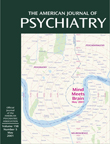Recurrence of Affective Disorder
To the Editor: In a report regarding the National Institute of Mental Health (NIMH) study about the longitudinal course of affective disorder (1), David A. Solomon, M.D., and colleagues concluded that the risk of recurrence progressively increases with each successive affective episode. It is remarkable that the individual propensity toward recurrence is taken into account in the analyses (mixed-effect, grouped-time survival analyses). To our knowledge, only our previous study (2) has done this as well. In that study, so-called frailty models were used to analyze the effect of prior episodes on the risk of recurrence in unipolar and bipolar disorder. An episode effect was demonstrated in bipolar affective disorder in general and in women with unipolar disorder. However, for unipolar men, no effect of prior episodes was found when the effect was adjusted for frailty.
It must be realized that when individual heterogeneity is not considered in the analysis, one may falsely conclude that there is an effect of prior episodes on the risk of recurrence in affective disorder. This is due to a selection phenomenon: the statistical average course of the illness for a group of patients may be dominated by the course of episodes for the most ill patients. If patients with several episodes have a constant high risk of recurrence from the first episode, then these patients will increasingly influence the pattern for each subsequent episode, because they will constitute an increasing proportion of the remaining sample. Thus, in every study sample, a subset of subjects from the sample have a great tendency toward recurrence from the beginning of the illness, and this subsample will then affect the analysis of the whole sample.
It would be interesting to reanalyze data from the NIMH study separately for men and women, still taking individual heterogeneity into account and, similarly, to analyze data for patients included in the NIMH study with bipolar disorder. Angst and Preisig are currently reanalyzing their data (3), taking individual heterogeneity into account (personal communication). It would also be interesting to reanalyze data from other longitudinal studies of patients with affective disorders.
1. Solomon DA, Keller MB, Leon AC, Mueller TI, Lavori PW, Shea MT, Coryell W, Warshaw M, Turvey C, Maser JD, Endicott J: Multiple recurrences of major depressive disorder. Am J Psychiatry 2000; 157:229–233Link, Google Scholar
2. Kessing LV, Olsen EW, Andersen PK: Recurrence in affective disorder: analyses with frailty models. Am J Epidemiol 1999; 149:404–411Crossref, Medline, Google Scholar
3. Angst J, Preisig M: Course of a clinical cohort of unipolar, bipolar and schizoaffective patients: results from a prospective study from 1959 to 1985. Scheiz Arch Neurol Psychiatrie 1995; 146:5–16Medline, Google Scholar



